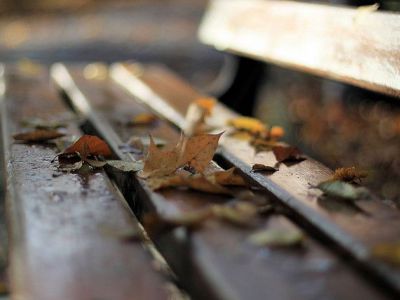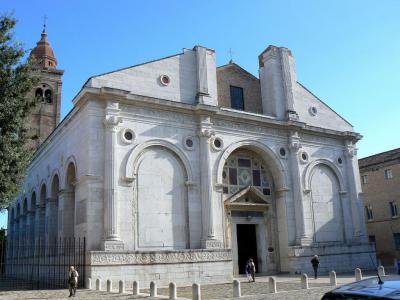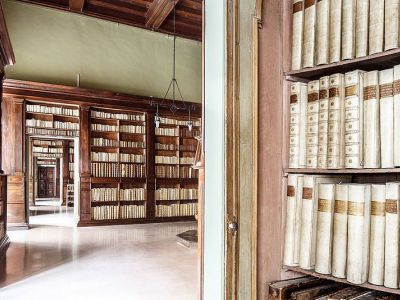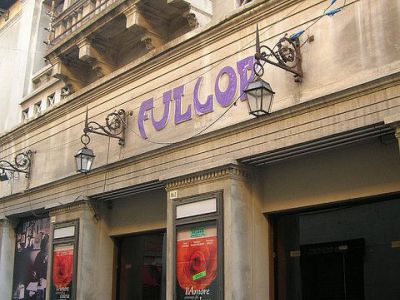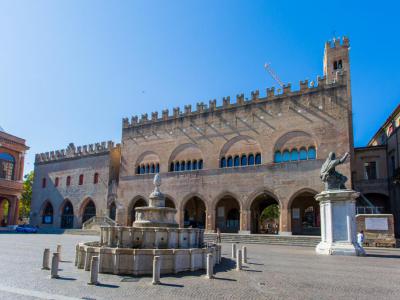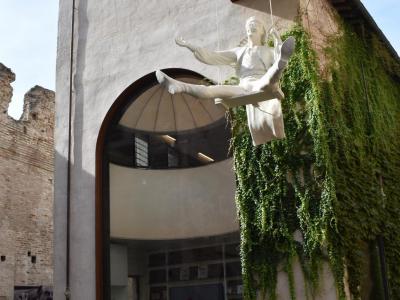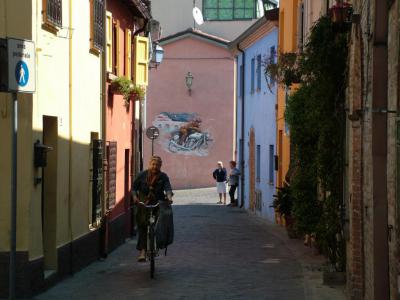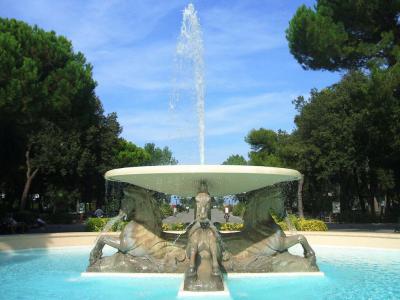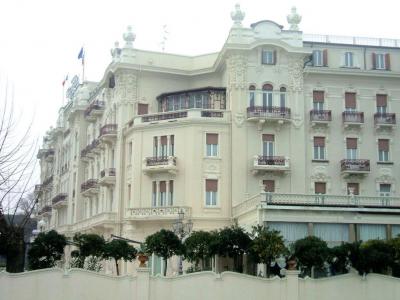
Federico Fellini Trail (Self Guided), Rimini
Even those vaguely familiar with cinema perhaps have heard of Federico Fellini. In recent history, the picturesque resort town of Rimini, on the Adriatic coast of Italy, "marked" itself primarily as the birthplace and the final resting place of this great film director.
Fellini lived in Rimini from January 1920, when he was born, until January 1939, when he moved out to Rome. While not having made a single movie in his hometown, Fellini often talked about those 19 years he had spent here. And the citizens of Rimini duly reciprocate, often cashing in on and giving the name of their famous fellow countryman to everything they can. There is an international airport named after Fellini, a railway station, and a bus station, not to mention an entire quarter of the town and one of the local parks.
The romance between Federico and motion picture began at Cinema Fulgor; here, as a young kid, he watched "Maciste all'Inferno" sitting on his dad's lap. Later, Cinema Fulgor appeared in Fellini's Roma and it's where everybody tries to conquer the heart of the La Gradisca character in Amarcord.
At the height of his fame, the Maestro used to return to Rimini usually at night, leaving early in the following morning, just to spend a few hours talking with his childhood friend, Titta, in their favorite "secret hideout", the cozy Piazzetta Teatini.
Another location, the director's museum in the 15th-century Castel Sismondo, designed by Brunelleschi, is now a popular attraction with both locals and tourists. Inside, you will find numerous images of Maestro's wife, Giulietta Masina, a special section dedicated to his friend, poet and author, Tonino Guerra, and other exhibits illustrating Fellini's beloved topic, the world of dreams: "Nulla si sa, tutto si immagina" (Nothing is known, everything is imagined).
Borgo San Giuliano, also known as the Fellini quarter, is a delightful neighbourhood in which the Italian movie maker grew up. It is now lavishly adorned with street art, featuring characters and locations from his works.
To honor Federico, you can also visit the Grand Hotel where young Fellini once worked as a caricaturist and which he loved so much that he replicated it in Cinecittà studios in Rome for Amarcord.
To immerse in the atmosphere that enchanted the future great cinematographer and to discover Rimini, the city in which he was born and died, through the eyes of its illustrious son, take this self-guided walking tour.
Fellini lived in Rimini from January 1920, when he was born, until January 1939, when he moved out to Rome. While not having made a single movie in his hometown, Fellini often talked about those 19 years he had spent here. And the citizens of Rimini duly reciprocate, often cashing in on and giving the name of their famous fellow countryman to everything they can. There is an international airport named after Fellini, a railway station, and a bus station, not to mention an entire quarter of the town and one of the local parks.
The romance between Federico and motion picture began at Cinema Fulgor; here, as a young kid, he watched "Maciste all'Inferno" sitting on his dad's lap. Later, Cinema Fulgor appeared in Fellini's Roma and it's where everybody tries to conquer the heart of the La Gradisca character in Amarcord.
At the height of his fame, the Maestro used to return to Rimini usually at night, leaving early in the following morning, just to spend a few hours talking with his childhood friend, Titta, in their favorite "secret hideout", the cozy Piazzetta Teatini.
Another location, the director's museum in the 15th-century Castel Sismondo, designed by Brunelleschi, is now a popular attraction with both locals and tourists. Inside, you will find numerous images of Maestro's wife, Giulietta Masina, a special section dedicated to his friend, poet and author, Tonino Guerra, and other exhibits illustrating Fellini's beloved topic, the world of dreams: "Nulla si sa, tutto si immagina" (Nothing is known, everything is imagined).
Borgo San Giuliano, also known as the Fellini quarter, is a delightful neighbourhood in which the Italian movie maker grew up. It is now lavishly adorned with street art, featuring characters and locations from his works.
To honor Federico, you can also visit the Grand Hotel where young Fellini once worked as a caricaturist and which he loved so much that he replicated it in Cinecittà studios in Rome for Amarcord.
To immerse in the atmosphere that enchanted the future great cinematographer and to discover Rimini, the city in which he was born and died, through the eyes of its illustrious son, take this self-guided walking tour.
How it works: Download the app "GPSmyCity: Walks in 1K+ Cities" from Apple App Store or Google Play Store to your mobile phone or tablet. The app turns your mobile device into a personal tour guide and its built-in GPS navigation functions guide you from one tour stop to next. The app works offline, so no data plan is needed when traveling abroad.
Federico Fellini Trail Map
Guide Name: Federico Fellini Trail
Guide Location: Italy » Rimini (See other walking tours in Rimini)
Guide Type: Self-guided Walking Tour (Sightseeing)
# of Attractions: 9
Tour Duration: 2 Hour(s)
Travel Distance: 3.4 Km or 2.1 Miles
Author: Dara
Sight(s) Featured in This Guide:
Guide Location: Italy » Rimini (See other walking tours in Rimini)
Guide Type: Self-guided Walking Tour (Sightseeing)
# of Attractions: 9
Tour Duration: 2 Hour(s)
Travel Distance: 3.4 Km or 2.1 Miles
Author: Dara
Sight(s) Featured in This Guide:
- Piazzetta Teatini
- Tempio Malatestiano (Malatestiano Temple)
- Cineteca Comunale in Palazzo Gambalunga (Gambalunga Palace Cinematheque)
- Fellini Museum and Cinema Fulgor
- Piazza Cavour (Cavour Square)
- Sismondo Castle and Fellini Museum
- Borgo San Giuliano and Piazzetta Gabena
- Parco Fellini (Fellini Park)
- Grand Hotel Rimini
1) Piazzetta Teatini
Piazzetta Teatini, a small green space outside the majestic Tempio Malatestiano (a glowing white cathedral named for the medieval lords of the region) is where the echoes of the past are still heard, resounding from the ruins of the Church of the Fathers of Teatini (Chiesa dei Padri Teatini). This church, built between 1613 and 1629 on the site of yet another temple, the San Giorgio Anti church, was almost completely destroyed by bombing during World War II. Currently, only one of its walls remains in place, overlooking the Piazzetta Teatini gardens.
In contrast to the cathedral’s grandeur, Piazzetta Teatini was long overlooked and eventually got overgrown, becoming a spot of splotchy grass with a few benches.
The early success made Fellini feel a bit uneasy in his hometown. “I don't like going back to Rimini, I have to say. It's a kind of block.” Therefore, oftentimes he visited Rimini in secret from everyone, except family and friends.
The head of the Fellini Foundation, Sergio Zavoli, said that Federico often came at night. He would meet his childhood friend, Luigi "Titta" Benzi, together with whom they went to this piazzetta and talked all night while kicking around an empty can. By the break of dawn, when the city awoke, Fellini was gone, catching an early train back to Rome.
If you're not in a hurry, consider checking out the nearby Ristorante Teatini for an excellent meal of squid-ink passatelli – served on spaetzle (a type of noodles), as the locals do – washed down with a glass of famoso, a floral white wine from the region, to reinforce the experience.
In contrast to the cathedral’s grandeur, Piazzetta Teatini was long overlooked and eventually got overgrown, becoming a spot of splotchy grass with a few benches.
The early success made Fellini feel a bit uneasy in his hometown. “I don't like going back to Rimini, I have to say. It's a kind of block.” Therefore, oftentimes he visited Rimini in secret from everyone, except family and friends.
The head of the Fellini Foundation, Sergio Zavoli, said that Federico often came at night. He would meet his childhood friend, Luigi "Titta" Benzi, together with whom they went to this piazzetta and talked all night while kicking around an empty can. By the break of dawn, when the city awoke, Fellini was gone, catching an early train back to Rome.
If you're not in a hurry, consider checking out the nearby Ristorante Teatini for an excellent meal of squid-ink passatelli – served on spaetzle (a type of noodles), as the locals do – washed down with a glass of famoso, a floral white wine from the region, to reinforce the experience.
2) Tempio Malatestiano (Malatestiano Temple) (must see)
The Malatestiano Temple is the unfinished cathedral of Rimini built in the 13th century. The Gothic-style church belonged to the Franciscans, featuring a single nave and three apses but no side chapels. Frescoes by painter Giotto di Bondone adorned the central chapel. He also created the crucifix housed now in the right chapel.
Sigismondo Pandolfo Malatesta, a captain, nobleman, and poet known as the "Wolf of Rimini" for his military prowess, acquired the edifice and commissioned its reconstruction in 1450. He intended to develop the church as a mausoleum for himself and his wife, Lady Isotta degli Atti, who governed Rimini as a regent between 1460-1462 and 1468–1469.
Renaissance architect Leon Battista Alberti was approved to design the Temple. Alberti drew on ancient Roman structures for his inspiration. He used the concept of the triumphal arch, including the Arch of Augustus in Rimini. Large arcades on the sides recall the Roman aqueducts. The triangular pediment above the door has a decorated tympanum.
There are seven chapels with the remains of prominent Riminese citizens. The church was considered by Pope Pius II an exaltation of "pagan gods and profane things." Malatesta was excommunicated in 1460 as his fortunes declined. He died in 1468.
Sigismondo Pandolfo Malatesta, a captain, nobleman, and poet known as the "Wolf of Rimini" for his military prowess, acquired the edifice and commissioned its reconstruction in 1450. He intended to develop the church as a mausoleum for himself and his wife, Lady Isotta degli Atti, who governed Rimini as a regent between 1460-1462 and 1468–1469.
Renaissance architect Leon Battista Alberti was approved to design the Temple. Alberti drew on ancient Roman structures for his inspiration. He used the concept of the triumphal arch, including the Arch of Augustus in Rimini. Large arcades on the sides recall the Roman aqueducts. The triangular pediment above the door has a decorated tympanum.
There are seven chapels with the remains of prominent Riminese citizens. The church was considered by Pope Pius II an exaltation of "pagan gods and profane things." Malatesta was excommunicated in 1460 as his fortunes declined. He died in 1468.
3) Cineteca Comunale in Palazzo Gambalunga (Gambalunga Palace Cinematheque)
The Gambalunga Palace, seat of the Gambalunga Civic Library, is also home to the Municipal Film Library, the Cineteca.
This cinematheque is one of the most important video archives in Italy, with a huge multimedia gallery. Open since 1987, it has to date amassed a rich collection of movie-related items including more than 17,000 books and other printed publications (posters, playbills, photographs, and magazines, both Italian and foreign) as well as over 10,000 motion pictures, on 35 and 16mm films, with various audiovisual support.
A special section within the cinematheque is dedicated to Federico Fellini. After the dissolution of the Federico Fellini Foundation, in 2015, the Cineteca acquired its archive, consisting of drawings and posters, as well as manuscripts, typescripts, documents from the set, screenplays, scores and audiovisual material. Another association with Fellini is that the top floor of the building, back in the day, used to house a secondary school which the future film director attended.
This cinematheque is one of the most important video archives in Italy, with a huge multimedia gallery. Open since 1987, it has to date amassed a rich collection of movie-related items including more than 17,000 books and other printed publications (posters, playbills, photographs, and magazines, both Italian and foreign) as well as over 10,000 motion pictures, on 35 and 16mm films, with various audiovisual support.
A special section within the cinematheque is dedicated to Federico Fellini. After the dissolution of the Federico Fellini Foundation, in 2015, the Cineteca acquired its archive, consisting of drawings and posters, as well as manuscripts, typescripts, documents from the set, screenplays, scores and audiovisual material. Another association with Fellini is that the top floor of the building, back in the day, used to house a secondary school which the future film director attended.
4) Fellini Museum and Cinema Fulgor
The Valloni Palace at Augusto Street, number 162, was owned by the noble brothers Demofonte and Aurelio Valloni. The facade of the building was completely rebuilt in 1787 as designed by the Neoclassicist architect Giuseppe Valadier. After restorations in 1920 by architect Addo Cupi, the Palace became Cinema Fulgor.
The cinema has been closed for a few years but reopened as part of the new Fellini Museum in Rimini, dedicated to filmmaker Federico Fellini. The opening, on the occasion of Fellini's 100th birthday celebration, recalls the former glory of the earlier Fulgor, a regional cinema showing Fellini's films, Roma and Amarcord.
The restored Art Nouveau building opened with two rooms dedicated to film showings, Federico Room (seating 190) and Giulietta Room (seating 52). The building has three floors with Fellini's poetry, photos, portraits, posters, projects, and unfulfilled ideas.
The two screening rooms on the ground floor were designed by Oscar winner and production designer Dante Ferretti in the old Hollywood style. The main movie screen is located on the second floor.
On the uppermost floor is a loft space showing projected sequences of Fellini's films on the walls. The ceiling has a reproduction of the astral chart of Fellini's birth, January 20, 1920.
The cinema has been closed for a few years but reopened as part of the new Fellini Museum in Rimini, dedicated to filmmaker Federico Fellini. The opening, on the occasion of Fellini's 100th birthday celebration, recalls the former glory of the earlier Fulgor, a regional cinema showing Fellini's films, Roma and Amarcord.
The restored Art Nouveau building opened with two rooms dedicated to film showings, Federico Room (seating 190) and Giulietta Room (seating 52). The building has three floors with Fellini's poetry, photos, portraits, posters, projects, and unfulfilled ideas.
The two screening rooms on the ground floor were designed by Oscar winner and production designer Dante Ferretti in the old Hollywood style. The main movie screen is located on the second floor.
On the uppermost floor is a loft space showing projected sequences of Fellini's films on the walls. The ceiling has a reproduction of the astral chart of Fellini's birth, January 20, 1920.
5) Piazza Cavour (Cavour Square) (must see)
Cavour Square is one of the main historical squares of Rimini, which reflects the history of the city and the spirit of past centuries. As the center of city life since the middle ages, the square is bordered by buildings of interest. Podesta building and its battlements and Gothic arches date from 1334. The neighboring Palace dell' Arengo was built in 1204. Malatestiano Temple and City Museum are on the square as well.
Although Cavour Square is not as big as Three Martyrs' Square, it is more popular with the locals. One side of the square is lined with coffee shops. Malatesta Square and Cavour Square are the venues for the largest weekly open-air market in the Emilia Romagna region.
A statue of Pope Paul V, by sculptor Sebastiano Sebastiani, has stood in the center of the square since the 17th century. Near the sculpture is the Pine Cone Fountain (Fontana della Pigna), built in Roman times. It was the only source of drinking water for Rimini until 1912.
On the Fountain can be seen numerous commemorative plaques. The most famous testimony is the one left by Leonardo da Vinci during his visit to Rimini: "Make a harmony with the different falls of water, as you saw at the source of Rimini, as you saw on August 5, 1502".
Federico Fellini often spoke about the square. He reproduced the square as a set at the film studio Cinecitta in Rome.
Although Cavour Square is not as big as Three Martyrs' Square, it is more popular with the locals. One side of the square is lined with coffee shops. Malatesta Square and Cavour Square are the venues for the largest weekly open-air market in the Emilia Romagna region.
A statue of Pope Paul V, by sculptor Sebastiano Sebastiani, has stood in the center of the square since the 17th century. Near the sculpture is the Pine Cone Fountain (Fontana della Pigna), built in Roman times. It was the only source of drinking water for Rimini until 1912.
On the Fountain can be seen numerous commemorative plaques. The most famous testimony is the one left by Leonardo da Vinci during his visit to Rimini: "Make a harmony with the different falls of water, as you saw at the source of Rimini, as you saw on August 5, 1502".
Federico Fellini often spoke about the square. He reproduced the square as a set at the film studio Cinecitta in Rome.
6) Sismondo Castle and Fellini Museum
Sismondo Castle, also called Malatestian Stronghold (Rocca Malatestiana), has undergone a substantial transformation. Once the fortress home of 14th century Lord Sigismondo Pandolfo Malatesta, the dreaded "Wolf of Rimini," it has been, since 2020, a part of a fantasy museum dedicated to the genius of Rimini's own, Federico Fellini.
One day, young Federico ran away from home. He got as far as the Malatestian Stronghold. In front of the forbidding castle were a circus tent and carnival, a manifestation of his destiny to spend his life creating dreams and fantasies in film.
The Fellini Museum comes in three parts. Sismondo Castle is joined by the Valloni Palace, housing the Fulgor Cinema, used in the film Amarcord. The third part is the open spaces of Malatesta Square, now called the Square of Dreams (Piazza Dei Sogni). The square creates a passage of interactive visuals connecting the Fulgor and the Castle.
In the Renaissance Castel, museum-goers are immersed in Fellini's dreams and fantasies. One room is devoted to the Maestro's wife, Giulietta Masina, star of "La Strada" and "Nights of Cabiria." Interactive panels, memorabilia, reams of photos, clips of films, and the Director's library are accessible.
In the square, a large circular bench evokes the ring-around-the-Rosie scene from "8 1/2." An enormous fountain continuously sprays a fog-like mist often featured in his films. Some say the whole thing is over-the-top, but then, this is Fellini.
One day, young Federico ran away from home. He got as far as the Malatestian Stronghold. In front of the forbidding castle were a circus tent and carnival, a manifestation of his destiny to spend his life creating dreams and fantasies in film.
The Fellini Museum comes in three parts. Sismondo Castle is joined by the Valloni Palace, housing the Fulgor Cinema, used in the film Amarcord. The third part is the open spaces of Malatesta Square, now called the Square of Dreams (Piazza Dei Sogni). The square creates a passage of interactive visuals connecting the Fulgor and the Castle.
In the Renaissance Castel, museum-goers are immersed in Fellini's dreams and fantasies. One room is devoted to the Maestro's wife, Giulietta Masina, star of "La Strada" and "Nights of Cabiria." Interactive panels, memorabilia, reams of photos, clips of films, and the Director's library are accessible.
In the square, a large circular bench evokes the ring-around-the-Rosie scene from "8 1/2." An enormous fountain continuously sprays a fog-like mist often featured in his films. Some say the whole thing is over-the-top, but then, this is Fellini.
7) Borgo San Giuliano and Piazzetta Gabena
The Borgo, or district of San Giuliano, dates from the 11th century. From the beginning, it was a small fishing village outside the city walls of Rimini. The Bridge of Tiberius connects the district directly to the Old City center. In the early 20th century, San Giuliano was incorporated into the city itself.
The neighborhood of San Giuliano lies between the River Marecchina and the Canal Rimini, south of the river. The streets are cobbled and narrow. A labyrinth comes to mind. Multi-colored single and two-story houses line the twisting lanes. But what particularly stands out are the murals that cover many of the walls. These colorful scenes tell different stories, projecting different messages.
In the mid-1980s, developers moved to demolish the neighborhood to raise modern, more expensive housing. The Borghigiani activist group resisted change. They publicized the district with a festival called Feast of Borg (Festa de Borg). The Borg has transformed from an impoverished neighborhood into a little pocket of colors and charm. Today is popular with artists, writers, and musicians.
In Gabena Square (Piazzetta Gabena,) there are fantastic murals showing scenes from Fellini's life and films. The visitors can admire a mural painting of Gelsomina, the leading character of Fellini's drama "La Strada" (The Street). She is climbing a pole. Close by is the erotic kiss of "La Dolce Vita" (The Sweet Life). The district is best explored by walking or by bicycle. The Borgo is a town apart, and there are many reasons to visit it.
The neighborhood of San Giuliano lies between the River Marecchina and the Canal Rimini, south of the river. The streets are cobbled and narrow. A labyrinth comes to mind. Multi-colored single and two-story houses line the twisting lanes. But what particularly stands out are the murals that cover many of the walls. These colorful scenes tell different stories, projecting different messages.
In the mid-1980s, developers moved to demolish the neighborhood to raise modern, more expensive housing. The Borghigiani activist group resisted change. They publicized the district with a festival called Feast of Borg (Festa de Borg). The Borg has transformed from an impoverished neighborhood into a little pocket of colors and charm. Today is popular with artists, writers, and musicians.
In Gabena Square (Piazzetta Gabena,) there are fantastic murals showing scenes from Fellini's life and films. The visitors can admire a mural painting of Gelsomina, the leading character of Fellini's drama "La Strada" (The Street). She is climbing a pole. Close by is the erotic kiss of "La Dolce Vita" (The Sweet Life). The district is best explored by walking or by bicycle. The Borgo is a town apart, and there are many reasons to visit it.
8) Parco Fellini (Fellini Park)
Conveniently located just a stone's throw from the beaches of the Marina Centro area and the historic downtown, Parco Federico Fellini (Federico Fellini Park) is a wonderful place for escaping the city's hustle and bustle, ideally suited for tourists seeking a short break before continuing on their leisurely walk.
Not so big in size, this park is one of the most visited in Rimini, and is named after its most famous citizen, Federico Fellini. Each portion of the park is amply shaded by large trees, mostly evergreen, with a prevalence of fragrant Aleppo pines, holm oaks, tamarisks and poplars. On the one side, it borders the garden of the adjacent Grand Hotel Rimini.
Built after the Second World War, the park blooms more and more every year, as if charged by the energy of satisfied vacationers. In addition to several sculptures, shaded promenade and two small playgrounds for children, the park has, as its centerpiece, the beautiful Fontana dei Quattro cavalli (the Four Horses Fountain), a marble relic from the Kursaal gardens that once existed here in the 19th century. The fountain was originally built in 1928 for the Kursaal ("Cure Hall" in German) bathing complex. Demolished in the 1950s, it was then rebuilt, complete with its original elements, in 1983.
Another curious attraction in the park, installed in the 1960s, is an information booth in the form of a giant photo camera, a subtle reference to the famous film director. There are also four busts commemorating the founders of the local tourist business, namely: Paolo Mantegazza, Augusto Muri, Ruggero Baldini and Claudio Tintori.
The fantastic atmosphere of the area's old days was immortalized in some of Fellini's movies, such as Amarcord, depicting the luxurious Grand Hotel, so dear to many of the locals.
Presently, Fellini Park regularly hosts different shows and festivals, including the traditional annual Amarcort Film Festival, the only festival in the world dedicated to Federico Fellini, held in his hometown.
Not so big in size, this park is one of the most visited in Rimini, and is named after its most famous citizen, Federico Fellini. Each portion of the park is amply shaded by large trees, mostly evergreen, with a prevalence of fragrant Aleppo pines, holm oaks, tamarisks and poplars. On the one side, it borders the garden of the adjacent Grand Hotel Rimini.
Built after the Second World War, the park blooms more and more every year, as if charged by the energy of satisfied vacationers. In addition to several sculptures, shaded promenade and two small playgrounds for children, the park has, as its centerpiece, the beautiful Fontana dei Quattro cavalli (the Four Horses Fountain), a marble relic from the Kursaal gardens that once existed here in the 19th century. The fountain was originally built in 1928 for the Kursaal ("Cure Hall" in German) bathing complex. Demolished in the 1950s, it was then rebuilt, complete with its original elements, in 1983.
Another curious attraction in the park, installed in the 1960s, is an information booth in the form of a giant photo camera, a subtle reference to the famous film director. There are also four busts commemorating the founders of the local tourist business, namely: Paolo Mantegazza, Augusto Muri, Ruggero Baldini and Claudio Tintori.
The fantastic atmosphere of the area's old days was immortalized in some of Fellini's movies, such as Amarcord, depicting the luxurious Grand Hotel, so dear to many of the locals.
Presently, Fellini Park regularly hosts different shows and festivals, including the traditional annual Amarcort Film Festival, the only festival in the world dedicated to Federico Fellini, held in his hometown.
9) Grand Hotel Rimini
The Grand Hotel Rimini is an elegant historical landmark and a national monument since 1994. This true symbol of the Belle Epoque, designed in the Art Nouveau style, was created by the South American architect Paolo Somazzi.
Since its inauguration in 1908, the legendary hotel has lived in step with the history of Italy, being a protagonist of the story of the Riviera development and Italian tourism, welcoming during its existence a plethora of celebrities: aristocrats, Nobel Laureates, politicians and kings. The international appeal and the five-star hospitality of the Grand Hotel were largely complemented by the myth of Federico Fellini, whose genius brought it to a worldwide fame in the 1973 movie, Amarcord, exalting its charm, and fixing it forever in a timeless dimension.
The hotel served as an inspiration to Fellini in his childhood years, who saw it as the manifestation of forbidden desires – "the fable of wealth, luxury, and splendor." Titta Benzi, one of Fellini's best friends, recalled the hours they spent outside of the Grand Hotel peeking through its hedge to spy on the unreal world of the rich. Long gone now are the days when the once penniless Fellini sneaked into the hotel lobby to watch the work of telephone operators (something he enjoyed the most), only to be escorted out by the surly concierge.
When he grew up, Fellini became friends with the hotel's owner, Cavalier Arpesella, and used to spend here a good deal of time, invariably staying in room 315 – the Fellini Suite (overlooking the garden and the sea) – that was always reserved for him. From here, the Maestro could see “a Rimini that never ends,” with an “endless procession of shimmering cars “ making it look like Rome, only smaller and a bit less crazy.
Inside the room, there are photos of Fellini on the terrace with his wife, Giulietta Masina. The red sofas making up the interior recall the moments of relaxation of the prestigious guests whom the young Federico used to portray in his caricatures and drawings, and which gave him, apart from his first paycheck, an infinite number of characters to display in his cinematographic works later on.
To mark the centenary of the Maestro, in 2020, the hotel launched a special program which included, among other elements, the La Dolce Vita Gourmet, Dolce Vita Spa, Breakfast with Federico Fellini, Aperitif La Dolce Vita, plus the “8 and 1/2 spaces of the Grand Hotel Rimini” itinerary.
Right in front of the Fellini Suite is the Guerra Suite, dedicated to his dear friend, Tonino Guerra, a screenwriter, multifaceted artist and visionary poet, who also reached 100 years that same year.
Last but not least – a bizarre coincidence – the Grand Hotel beach is the only location in town without a street number. Sitting exactly between the numbers 8 and 9, it seemingly makes it a Fellinian 8½...
Since its inauguration in 1908, the legendary hotel has lived in step with the history of Italy, being a protagonist of the story of the Riviera development and Italian tourism, welcoming during its existence a plethora of celebrities: aristocrats, Nobel Laureates, politicians and kings. The international appeal and the five-star hospitality of the Grand Hotel were largely complemented by the myth of Federico Fellini, whose genius brought it to a worldwide fame in the 1973 movie, Amarcord, exalting its charm, and fixing it forever in a timeless dimension.
The hotel served as an inspiration to Fellini in his childhood years, who saw it as the manifestation of forbidden desires – "the fable of wealth, luxury, and splendor." Titta Benzi, one of Fellini's best friends, recalled the hours they spent outside of the Grand Hotel peeking through its hedge to spy on the unreal world of the rich. Long gone now are the days when the once penniless Fellini sneaked into the hotel lobby to watch the work of telephone operators (something he enjoyed the most), only to be escorted out by the surly concierge.
When he grew up, Fellini became friends with the hotel's owner, Cavalier Arpesella, and used to spend here a good deal of time, invariably staying in room 315 – the Fellini Suite (overlooking the garden and the sea) – that was always reserved for him. From here, the Maestro could see “a Rimini that never ends,” with an “endless procession of shimmering cars “ making it look like Rome, only smaller and a bit less crazy.
Inside the room, there are photos of Fellini on the terrace with his wife, Giulietta Masina. The red sofas making up the interior recall the moments of relaxation of the prestigious guests whom the young Federico used to portray in his caricatures and drawings, and which gave him, apart from his first paycheck, an infinite number of characters to display in his cinematographic works later on.
To mark the centenary of the Maestro, in 2020, the hotel launched a special program which included, among other elements, the La Dolce Vita Gourmet, Dolce Vita Spa, Breakfast with Federico Fellini, Aperitif La Dolce Vita, plus the “8 and 1/2 spaces of the Grand Hotel Rimini” itinerary.
Right in front of the Fellini Suite is the Guerra Suite, dedicated to his dear friend, Tonino Guerra, a screenwriter, multifaceted artist and visionary poet, who also reached 100 years that same year.
Last but not least – a bizarre coincidence – the Grand Hotel beach is the only location in town without a street number. Sitting exactly between the numbers 8 and 9, it seemingly makes it a Fellinian 8½...
Walking Tours in Rimini, Italy
Create Your Own Walk in Rimini
Creating your own self-guided walk in Rimini is easy and fun. Choose the city attractions that you want to see and a walk route map will be created just for you. You can even set your hotel as the start point of the walk.
Rimini Introduction Walking Tour
The Roman Republic founded an outpost called Ariminus at the mouth of the river Marecchia in 268 BC. Rimini was a center of civil wars and invasions. Julius Caesar made his famous "Rubicon" speech to his troops in the city forum.
The city was an all-important junction. The ancient Roman road, via Flaminia, ended in Rimini at the Arch of Augustus, erected in 27 BC. Another old Roman... view more
Tour Duration: 2 Hour(s)
Travel Distance: 2.4 Km or 1.5 Miles
The city was an all-important junction. The ancient Roman road, via Flaminia, ended in Rimini at the Arch of Augustus, erected in 27 BC. Another old Roman... view more
Tour Duration: 2 Hour(s)
Travel Distance: 2.4 Km or 1.5 Miles
The Most Popular Cities
/ view all
